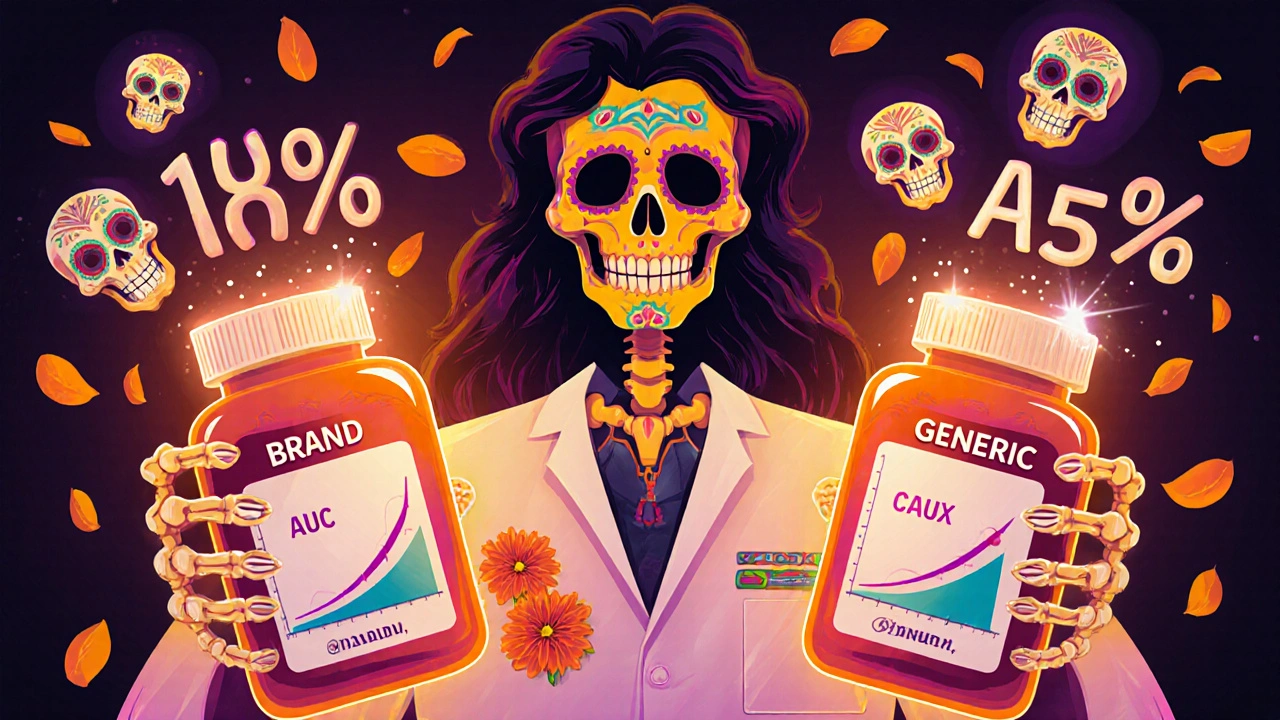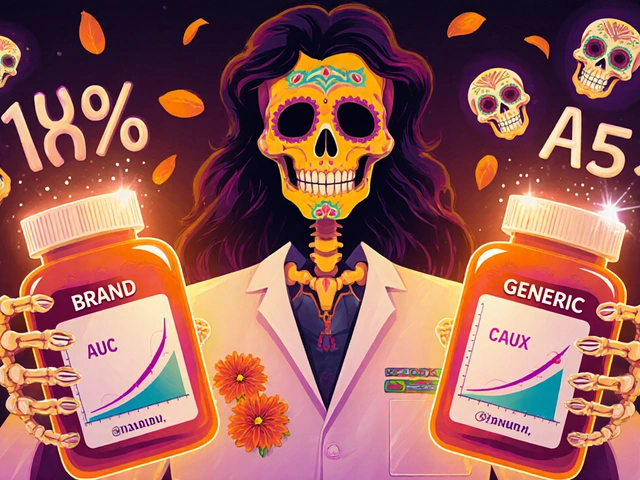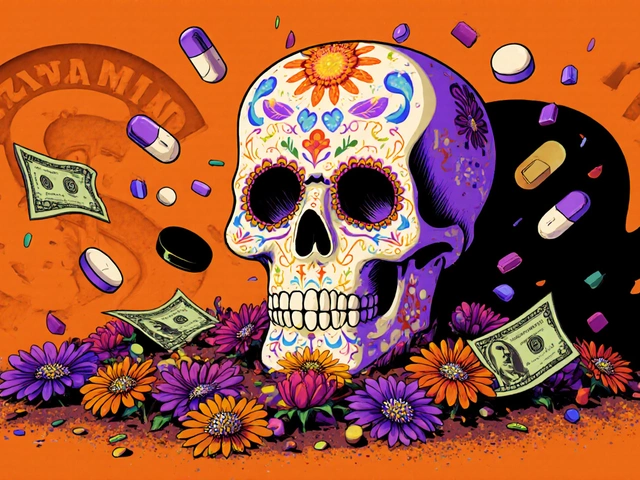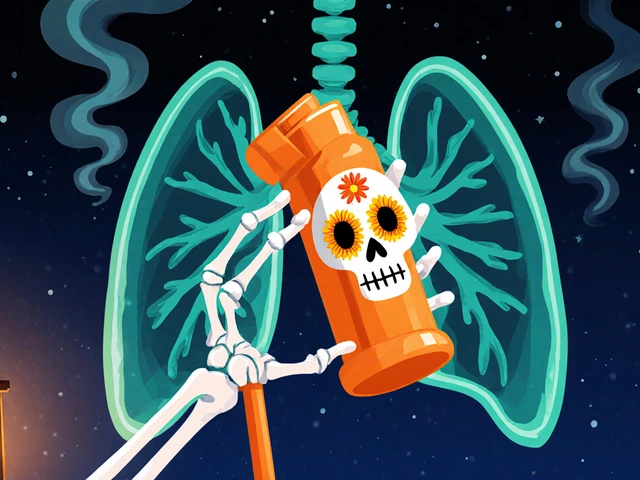How to Compare Bioavailability and Bioequivalence in Generic vs Brand Drugs

When you pick up a prescription, you might see two options: the brand-name pill you’ve always taken, or a cheaper generic version. You might wonder - are they really the same? The answer lies in two technical terms: bioavailability and bioequivalence. These aren’t just jargon. They’re the science that makes generic drugs safe, effective, and legal to swap for brand-name versions.
What Bioavailability Really Means
Bioavailability is about how much of a drug actually gets into your bloodstream after you take it. It’s not just about the dose on the label. If you swallow a 50 mg tablet, that doesn’t mean 50 mg enters your blood. Some of it might not dissolve. Some might get broken down by your stomach or liver before it ever circulates. That’s called first-pass metabolism. For example, a drug with 60% bioavailability means only 60% of the dose you take ends up active in your system. If you take 100 mg, only 60 mg does the work. That’s why intravenous (IV) drugs are considered 100% bioavailable - they go straight into your blood, no digestion needed. Bioavailability is measured using two key numbers: AUC (area under the curve) and Cmax (maximum concentration). AUC tells you how much drug your body is exposed to over time. Cmax tells you how high the peak level goes. Together, they paint a picture of how fast and how much the drug gets absorbed.What Bioequivalence Is - And Why It Matters
Bioequivalence is the comparison game. It answers: does this generic pill behave the same way in your body as the brand-name one? The FDA doesn’t just say “they’re the same.” They require proof. That proof comes from a clinical study - usually with 24 to 36 healthy volunteers. Each person takes the brand drug one time, then the generic another time, under strict conditions (fasting, same time of day, same blood draw schedule). Blood samples are taken every 15 to 30 minutes over 72 hours to track drug levels. The magic number? 80% to 125%. That’s the range the 90% confidence interval of the ratio between the generic and brand drug’s AUC and Cmax must fall into. If the generic’s AUC is 92% of the brand’s, that’s fine. If it’s 78%, it’s rejected. Same for Cmax. This isn’t arbitrary. It’s based on decades of data showing that differences within this range don’t lead to measurable differences in how well the drug works or how safe it is. Dr. Robert Lionberger from the FDA said in 2020 that this range balances patient safety with access to affordable meds.The Big Difference: One vs. Two Products
Here’s where people get confused. Bioavailability describes a single product. Bioequivalence compares two. Think of it like two cars. Bioavailability is how efficiently one car burns fuel - say, 25 miles per gallon. Bioequivalence is comparing that car to another model to see if they both get the same mileage under the same conditions. If Car B gets 24.5 mpg, they’re bioequivalent. If it gets 18 mpg, it’s not. That’s why you can’t say “this generic has 85% bioavailability.” You can only say “this generic is bioequivalent to the brand.” Bioavailability is a property. Bioequivalence is a conclusion.
When the Rules Get Tighter
Not all drugs are created equal - and not all need the same rules. Drugs with a narrow therapeutic index (NTI) are tricky. A little too much causes toxicity. A little too little means no effect. Think warfarin (blood thinner), levothyroxine (thyroid hormone), or phenytoin (seizure drug). For these, the FDA tightens the bioequivalence window. Instead of 80-125%, it’s often 90-111% for AUC. For warfarin, the AUC range is 90-112%. That’s because even a 10% difference can matter. Some pharmacists report patients switching from brand to generic levothyroxine who feel “off” - fatigue, weight gain, heart palpitations. The FDA says the generic meets bioequivalence standards. But patients still notice changes. Why? It could be small differences in fillers, coatings, or how the tablet dissolves. These don’t change AUC or Cmax enough to fail the test, but they might affect absorption speed in sensitive individuals. That’s why some doctors still prefer to keep patients on the same brand - especially if they’ve been stable for years.Real-World Evidence: Do Generics Work?
Let’s cut through the noise. Do generics actually work? A 2023 study from the American Pharmacists Association tracked 1,247 patients switched from brand to generic blood pressure meds. Only 17 (1.36%) reported issues. Of those, only 4 cases were confirmed as true therapeutic failures - not just perceived side effects. A 2022 survey by Patients for Better Drugs found 87.4% of 1,245 respondents noticed no difference after switching to generics. Only 3.8% of those who reported problems had medically confirmed bioequivalence-related issues. In other words: for most people, most of the time, generics are just as good. But here’s the catch: 99.7% of generics approved between 2010 and 2020 passed bioequivalence tests. That’s not luck. It’s rigorous science. The system works.What’s Changing Now?
The field isn’t stuck in the 1980s. New tools are emerging. For complex drugs - like inhalers, topical creams, or injectables - traditional blood tests don’t always show what’s happening at the site of action. A cream might absorb differently in the skin than in the blood. So regulators are testing new methods. The FDA is now exploring physiologically-based pharmacokinetic (PBPK) modeling. This uses computer simulations to predict how a drug behaves in the body based on its chemistry, your anatomy, and how your liver processes it. It’s not replacing blood tests yet - but it’s becoming a supporting tool, especially for complex generics. The European Medicines Agency is also testing whether in vitro dissolution tests (how fast a pill breaks down in a lab solution) can predict bioequivalence for certain drugs. If proven, this could cut study costs and speed up approvals.
What This Means for You
If you’re on a generic drug and feel fine - stick with it. The science backs it. If you’re switching from brand to generic and feel different - talk to your doctor. Don’t assume it’s “all in your head.” Track your symptoms. Ask if your drug has a narrow therapeutic index. Ask if the generic is from the same manufacturer as your brand. If you’re prescribed a new generic - ask if it’s been approved under the latest FDA guidelines. Most are. But for NTI drugs, some states still require prescribers to write “dispense as written” unless the pharmacist confirms bioequivalence. The bottom line: bioequivalence isn’t a marketing claim. It’s a legal requirement backed by hard data. The system isn’t perfect, but it’s one of the most rigorously tested areas in medicine.Quick Summary
- Bioavailability measures how much of a single drug gets into your bloodstream.
- Bioequivalence compares two drugs (usually brand vs. generic) to see if they deliver the same amount at the same rate.
- The FDA requires the 90% confidence interval of AUC and Cmax ratios to be between 80% and 125% for most drugs.
- Narrow therapeutic index drugs (like warfarin or levothyroxine) require tighter limits - often 90-111%.
- For 99.7% of generics approved since 2010, bioequivalence testing confirmed they work just like the brand.
Is bioequivalence the same as therapeutic equivalence?
Not exactly. Bioequivalence means two drugs have similar absorption rates and levels in the blood. Therapeutic equivalence means they work the same way in treating your condition. Bioequivalence is the scientific proof used to assume therapeutic equivalence. For most drugs, if they’re bioequivalent, they’re therapeutically equivalent. But for drugs with narrow therapeutic windows, doctors may still monitor outcomes even after bioequivalence is proven.
Can I trust a generic drug if it’s much cheaper?
Yes - if it’s FDA-approved. The price difference comes from lower marketing, R&D, and patent costs. The active ingredient, dosage, and bioequivalence standards are the same. Generic manufacturers must prove their product performs identically to the brand in clinical studies. The FDA inspects their factories just like brand-name ones.
Why do some people say generics don’t work for them?
Sometimes, it’s not the drug - it’s the change. Switching from a familiar brand to a new pill shape, color, or brand name can trigger placebo effects or anxiety. Other times, it’s a formulation difference - like a different filler - that affects how fast the drug dissolves in sensitive people. For NTI drugs, even small differences in absorption timing can matter. If you feel different after switching, track your symptoms and talk to your doctor. Don’t assume it’s all in your head.
Are all generics the same as each other?
No. Different manufacturers can make different generics of the same brand. Each one must meet bioequivalence standards on its own. One generic might be 95% bioequivalent, another 105%. Both are acceptable. But if you switch between different generics - say, from Generic A to Generic B - you might notice a change. That’s why some doctors recommend sticking with the same generic manufacturer once you’ve found one that works.
What happens if a generic fails bioequivalence testing?
It doesn’t get approved. The FDA rejects it. The manufacturer must redesign the formulation - change the filler, coating, or manufacturing process - and resubmit for testing. There’s no shortcut. Over 99% of submissions pass, but the ones that fail are pulled before they ever reach pharmacies.








Okay but have you ever actually seen the fillers in generics? I mean, the FDA says they’re ‘identical’ but the binders? The dyes? The coating? My cousin switched to a generic levothyroxine and started having heart palpitations. They told her it was ‘anxiety.’ LOL. I’ve seen this movie before - they say it’s safe until someone dies, then they ‘re-evaluate.’
USA made this system. Other countries don’t even test like this. China and India? They slap some powder in a capsule and call it a day. We’re the only ones with real standards. If you’re not using American-made generics, you’re playing Russian roulette with your health.
YASSS this post is fire 🔥 I love how you broke it down like a Netflix doc but with less drama. Seriously though - generics saved my ass when I was in college and living on ramen. My asthma inhaler? Generic. My blood pressure med? Generic. My sanity? Also generic. 😅
Hey, just wanted to say thank you for this. I'm a med student and this is the clearest explanation I've seen. I had no idea about the 80-125% rule. I'm gonna bookmark this for my pharmacology finals. You're a lifesaver. 👏
As someone who grew up in a household where we couldn’t afford brand-name meds, I can’t tell you how much this means. My mom took generic warfarin for 12 years. We had regular INR checks. She never had a clot or a bleed. Generics aren’t ‘second best’ - they’re the backbone of accessible healthcare. Thank you for validating what so many of us already know.
Let’s be real - the bioequivalence window is a farce. 80-125%? That’s a 45% variance. If I told you your insulin dose could vary by 45% and you’d be ‘fine,’ you’d laugh in my face. And yet we’re told to trust this? The FDA is compromised. Big Pharma owns them. Wake up.
Bro, the 80-125% thing? That’s not science - that’s corporate math. In India, we make generics for the whole world. But when I took my antiepileptic from a US brand vs. a US generic? I had a seizure. Coincidence? I think not. The system is rigged for profit, not patients.
Excellent breakdown. The AUC/Cmax metrics are the gold standard for a reason. I’ve reviewed dozens of generic bioequivalence studies in my work as a clinical pharmacologist. The data is rock solid. The exceptions? Rare. The fear? Mostly psychological. Stick with what works - but don’t fear the generic.
THEY’RE LYING TO YOU. I WORKED AT A PHARMACEUTICAL LAB. I SAW THE REPORTS. THE ‘BIOEQUIVALENCE’ STUDIES? THEY USE 24 PEOPLE WHO ARE 22 YEARS OLD, NON-SMOKERS, NO COMORBIDITIES. REAL PATIENTS? 65, DIABETIC, ON 7 MEDS? THEY NEVER TESTED IT ON THEM. THIS IS A SCAM. THEY’RE USING YOUR GRANDMA AS A GUINEA PIG.
Interesting. But what about the variability between different generic manufacturers? If Generic A and Generic B are both within 80-125%, but A is 90% and B is 110%, is switching between them safe? The post mentions this briefly, but it deserves more emphasis.
Man I switched to generic Adderall last year and I didn’t notice a thing. My boss even said I seemed more focused. Probably just the placebo, but hey - if it works, it works. Saved me $200 a month. Win-win.
THEY’RE TESTING ON HEALTHY VOLUNTEERS? That’s the whole problem. They don’t test on people with liver disease, kidney failure, or elderly patients with polypharmacy. This isn’t science - it’s a cover-up for Big Pharma to kill competition. You think they’d let a 10% difference slide if it was THEIR drug? NEVER.
But what is ‘equivalence’ really? Is it not just a mathematical illusion? We measure blood concentration, but what about receptor binding affinity? What about epigenetic modulation? What about the soul’s resonance with the pill’s color? We reduce life to numbers - and call it progress. The pill is not the medicine. The medicine is the intention. And intention is unquantifiable.
My dad’s on levothyroxine. Switched from Synthroid to a generic - he felt tired for 3 weeks. Doctor said ‘it’s fine.’ But we switched back and he’s fine now. So yeah, the science says it’s equivalent. But bodies aren’t lab rats. Some people notice. Respect that.
For NTI drugs, even 5% difference matters. I’ve seen patients on warfarin go from INR 2.1 to 3.8 after switching generics. That’s not placebo. That’s pharmacokinetics. The FDA’s 90-111% rule is a step in the right direction, but we need real-time therapeutic monitoring - not just blood draws every 72 hours.
Thanks for this. I’ve been a pharmacist for 18 years. I’ve seen patients panic over color changes. I’ve seen them refuse generics because ‘it’s not the same pill.’ I always explain: same active ingredient, same FDA approval, same science. But I also listen. If they’re worried? I’ll note it. Sometimes, peace of mind is part of the treatment.
Wait… so if I switch from Generic A to Generic B, both approved, but different manufacturers… I could get a different effect? And no one tells me? Who’s keeping track of which one I’m on? This feels like a loophole. Are they just… letting us play Russian roulette with our meds?
Just one sentence: generics saved my life and my wallet.